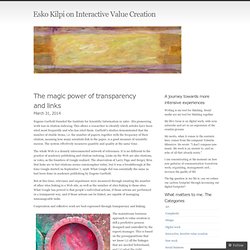

Harold Jarche. Home. SnapStore — Welcome. Evolution of the Mind: A Case for Design. Social Interaction Design by Adrian Chan. Enterprise I remember attending a local unconference for social startups several years ago.

This was in the heady days when social was fresh and much had yet to be defined. Session after session plumbed the myriad possibilities of mining user-generated content for valuable information. We had conversations about tagging, meta data, and standards — and the spirit of social sharing was genuine as tech-heads considered an ecosystem of open and federated social messaging, shared user activity, and notifications. What struck me then, as it still does, was the emphasis on information over communication. In my view, all online social activity is a form of communication. It may be a different market, but enterprise social is also a space in which buzz tends to focus on information: e.g. big data, social data, knowledge. To view this “information space” as communication is an important shift of interpretation. Most fundamentally, this kind of talk is work talk. Social_strategy_diagram.jpg (JPEG Image, 1540x792 pixels) - Scal.
Interactive, iterative value creation « Esko Kilpi on Interactiv. I took part in a high-level workshop on the future of work.

One of the questions raised was: “If machines can replace people’s minds in knowledge work as well as machines replaced their muscles in manual work, what will ultimately be left for human beings to do? Are we going to run out of jobs?” My answer was that this concern is based on a totally incorrect assumption. Working life does not consist of a finite number of problems and opportunities to which the human mind and human effort can be applied. The good news, or the bad news, is that the challenges that confront us are unlimited.
But technology does change what people should be doing and how organizations come to be what they are. When the Industrial Revolution began, the dominant Newtonian worldview meant that what was happening in the world was thought to be understandable without any reference to the environment in which things happened. Business enterprises were consequently thought of as machines. Background: New ways of interaction. Interactive. Interaction Institute for Social Change Blog. The structural vs. transformational debate is alive and well.

I’m glad that Curtis and Cynthia have been dipping back into it over the last few weeks. It is good to start at the end: the answer is a both/and, it’s not a good idea to get stuck in binaries. The print pictured above captures it for me. It is Nelson Mandela’s drawing of the view from his cell at Robben Island, where he was imprisoned for 30 years. Take that in for a second. Thirty years in jail for daring to stand up for freedom. The print’s beauty is undeniable. How is this perspective possible? There was something in Mandela’s mind, something in his soul, that could not be subjugated. Nelson Mandela is the icon that destroys the binary. I agree with Curtis and Glanzberg that “The pattern most in need of shifting is not out there in the world, but in our minds.”
But there is something else happening here. We have an interior condition. Bringing our care and attention to what is inside. Interaction Institute for Social Change. ICT-KM - Collaborate, Create, Communicate.